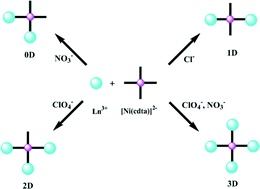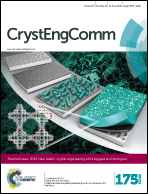Anion-controlled assembly of a series of heterometallic 3d–4f compounds with 0D cluster, 1D chain, 2D network and 3D frameworks†
Abstract
A series of heterometallic 3d–4f compounds, formulated as [Ln2Ni2(dcta)2(H2O)8(NO3)2]·8H2O (Ln = Nd (1); Ln = Dy (2)); {[DyNi(dcta)(H2O)6]·Cl·(H2O)2}n (3); {[LnNi(dcta)(H2O)6]·(ClO4)·(H2O)3}n (Ln = La (4); Ln = Nd (5)); {[Gd12Ni12(dcta)12(H2O)24]·[Ni(H2O)6]3·(ClO4)18·(H2O)80}n (6) and {[La12Ni12(dcta)12(H2O)60]·[Ni(H2O)6]3·(ClO4)18·(H2O)30}n (7), (H4dcta = trans-1,2-diaminocyclohexane-N,N,N′,N′-tetraacetic acid), have been obtained through a metalloligand strategy. Structural analysis reveals that [Ni(dcta)]2− acts as a bidentate metalloligand in 1–3, tridentate metalloligand in 4 and 5, and tetradentate metalloligand in 6 and 7. These compounds can be divided into four types according to the dimensionality of the structures. Compounds 1 and 2 are 0D tetranuclear clusters comprised of symmetric [LnNi(dcta)]2 12-membered rings, compound 3 is a 1D chain which is reinforced by hydrogen bonds. Compounds 4 and 5 possess an infinite 2D layer structure with a 63-hcb topology, and compounds 6 and 7 are two 3D frameworks constructed by face-sharing Keplerate-type metal–organic polyhedra. It is interesting that different anions lead to different topology structures. The magnetic properties and thermal stabilities of them are also studied.

- This article is part of the themed collection: 2016 New talent

 Please wait while we load your content...
Please wait while we load your content...